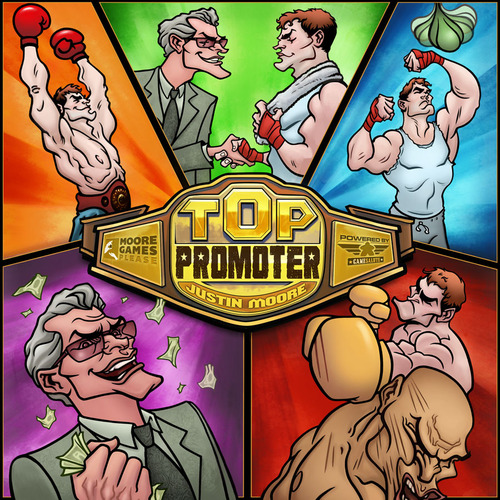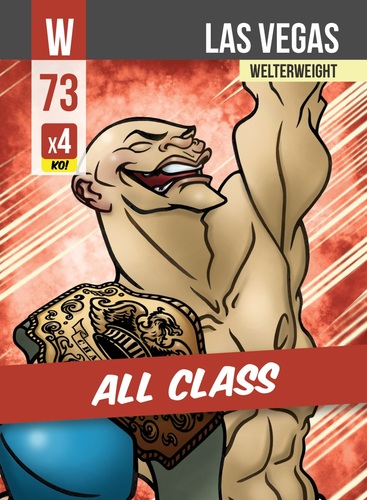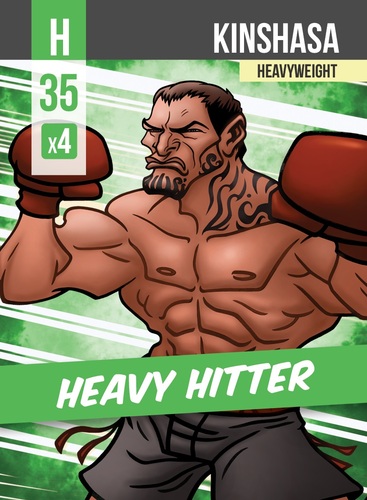Top Promoter—A Double-Take Preview (With Video!)
 "I'm gonna knock you out! Momma said, knock you out!" -LL Cool J
"I'm gonna knock you out! Momma said, knock you out!" -LL Cool J
Today we're taking a look at Top Promoter, a card and dice game that takes place in the world of competitive boxing. The game is designed for 2-5 players, and plays fairly quickly.
Players take to the table as promoters, trying to earn the most money by placing their fighters in bouts that they will hopefully win.
The Components
Cards—There are 5 nearly identical decks of 15 fighters and 5 action cards. We say nearly identical, because while all the boxers have the same name, each one has a different popularity value. This will make sense very shortly.
Dice—The final version will feature 7 dice per player color. We had prototypes that had just a handful of red and white.
Locations—More cards featuring cities/venues for the bouts.
The game starts by putting locations into play—one fewer than there are players. And the number of locations used in the game is scaled depending on the number of players in the game. (Because once they run out,the game is over.) Players then shuffle their decks and draw five cards.
Players then select a boxer from their hand and place it face down in front of them. Simultaneously they reveal their chosen boxer, and whoever has the most popular boxer chooses a location to place their boxer. Each location can take six boxers (three bouts, consisting of two boxers each: the low card, mid card and main event). You want to get your boxer into the main event because it pays more money. But once a fighter is put into a bout other players must match the weight class of that boxer. And you, of course, cannot pit your own fighters against themselves.
Once a location is filled (whether others are or not) you resolve the bouts at that location, pay out the prize money, discard all the boxers there, as well as the location card, and replace it with a new one from the location deck.
Bouts are resolved by rolling dice. Each boxer has a dice value printed on their card indicating how many dice you roll for them, and if that boxer is capable of a knock out. If they're able to KO a boxer, there are three different rolls that will accomplish that. A boxer with a 3 on his card needs to roll three-of-a-kind, a boxer with a 4 needs to roll a straight, and a 5 requires a full house roll. Players take the appropriate amount of dice and roll them, then compare highest to highest. If one player rolls a 5 as their highest and the other rolls a 3 as their highest, that's it: The fight is over and the player who rolled a 5 wins. If there is a tie you go to the next highest and compare, and so on.
There are action cards that can affect the payouts, or cause a fighter to forfeit, or move a bout into the main event slot, and so forth.
And that is pretty much the game. You choose boxers, try to maneuver them into the best bouts to get the best payouts, and then let them duke it out. Whoever has the most money when the locations run out is the Top Promoter!
Jeremiah—We can't really comment on the components for the game, since we were playing prototypes with tiddly-winks for money, and generic dice. I will say that the artwork in the form that we saw it in was nice, bright and colorful, and I enjoyed the cartoonish nature of it!
Firestone—Yeah, I liked the artwork, too—each fighter was unique and colorful and evocative.
Jeremiah—I really enjoyed half of the game. There are some great decision-making moments and strategic maneuvering to try and get your boxers into the best bout and then ratchet up the payouts with the special action cards to try and make a big score. I found this part of the game enjoyable and fun!
Firestone—Yeah, that was definitely the best part. You really had to think about when to play your special cards, because the moment a location was full, it was "scored," so you had to try and figure out if a location would score and you should play that card now or risk another go-around when you might be able to get yourself in an even better position to utilize a card.
Jeremiah—The bouts are where the whole thing fell apart for me. I don't mind dice AT ALL; I love dice, I own a lot of dice. But the bout mechanic is just too shallow for me. I can't get over the Risk-like feel of it. It doesn't matter what you do or how you jockey for position, you get, one, single, solitary roll to try and roll the highest number. Ugh. Yahtzee even gives you 2 re-rolls.
Firestone—Dice-disliker here... But even so, I like games that do interesting things with dice. THIS DOESN'T DO THAT. All that maneuvering and it comes down to one dice roll?! Aaargh! And there are ways to get more dice for your big rolls, but no way to change them or affect them in any way. So even if I manage to roll six dice to your two, if you roll a 6 and I roll all 5's, I LOSE! I understand that's kinda thematic, as sometimes the underdog does beat the big dog (Buster Douglas!), but...ugh.
Jeremiah Final Thoughts—I'm holding out hope that there will be an expansion that will add cards that allow you to tweak the dice, or alter them in some way that will make the bouts a little less of a flip of the coin. Time will tell. I have to say that until they do come up with some expansion or fix, Keep This On the Shelf.
Firestone Final Thoughts—There was some potential here, but it's been wasted with a terrible, terrible bout-resolution mechanism. I agree with Jeremiah: Keep This On the Shelf.
Thanks for reading, and feel free to watch the video review below. Have a great weekend! [youtube=http://www.youtube.com/watch?v=a51_OHjoF6g&w=560&h=315] 

